"Muddy Bunnies", "Dusty Bunnies", and "Bunny Tails"—this trio of short stories in Bunny Days feature Mr. and Mrs. Goat, six adorable bunnies, and a helpful bear. Children will enjoy each of these toy-stories that begin with a bunny mishap caused by Mr. or Mrs. Goat, and either a tractor, a vacuum cleaner, or garden tools. Bear always arrives on the scene to kindly fix any bunny trouble and everyone is happy!
You are here
A Baker's Dozen: The Best Children's Books for Family Literacy
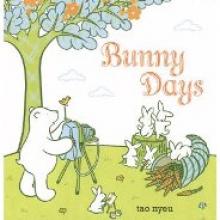
Bunny Days
Tips for Using with Children
Before reading this story, tell children that it is an example of a toy-story adventure. Ask the children if they have a favorite or special toy. After reading, ask the children to identify toys that are represented in the story (plush toys such as the bunnies, goats, and the bear, and other toys such as the tractor, washing machine, vacuum cleaner, sewing machine, etc.). Invite children to think of a story that includes one or two of their toys. Suggest that they act out the story or give the children a sheet of paper divided into three frames to draw a short adventure story for their toys that includes a beginning, middle, and an end. Invite them to tell their story aloud.
Tips for Using with Families
Point out that this book includes a table of contents page. Explain to parents that the book is an example of an easy reader chapter book. Discuss the simple patterned plot with parents. It’s a perfect choice for emergent readers to learn about the organization and predictability of short stories included in a book while enjoying some truly delightful bunny stories.
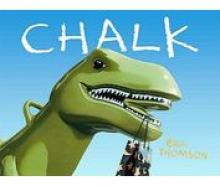
Chalk
Imagine a world where whatever you draw with a piece of chalk springs to life. A shining sun and beautiful butterflies fill the pages of this wonderfully illustrated story as children on a playground realize that the bag of chalk they found contains some magic. But what happens when one of the children decides to draw a ferocious dinosaur on the pavement? Discover the creativity within this wordless picture book as you watch your children’s vivid expressions and allow their imaginations to guide them in telling the story. It’s an adventure you don’t want to miss!
Tips for Using with Children
Allow children’s imaginations (and vocabulary) to soar as they invent words to accompany the illustrations in this book. Children will love to tell the story in their own way. A fun extension activity is to ask children to imagine that they are with the other children in the story. How would they stop the dinosaur? What would they draw with their piece of chalk? Provide chalk, and allow children to draw a picture and describe what might happen if their drawing came to life. The pictures could be collected into a special book designed by the children.
Tips for Using with Families
Before sharing this story with a child, families may want to preview the book and think of some questions that they want to ask their child when reading. Questions like “What did the children find?” and “How do you think they felt when the dinosaur came to life?” will help spark children’s storytelling. Families can set the stage for children by asking them to think about times they have drawn with chalk outside. In what ways can chalk drawings be erased? It might be a good idea to talk with children about the ending of the story, too. For example, families can ask children what they think will happen next. These questions can help to fill the pages of a wordless picture book with a LOT of interesting conversation!
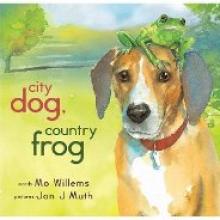
City Dog, Country Frog
City Dog and Country Frog meet for the first time in the spring, and they play Country Frog games. In the summer, they play City Dog games. By Fall, Frog is too tired out, and the pals simply recall their past fun. Sadly, Country Frog does not return in the winter. However, City Dog discovers friendship again in the spring. The beautiful, expressive watercolors enhance the action and give insight into a range of feelings that children will want to discuss. They will return to their favorite pictures and want to hear the book numerous times.
Tips for Using with Children
Children will love the pictures in this book, especially if some of the details are pointed out to them (e.g., Country Frog throwing the stick for City Dog to fetch, Country Frog holding the leaf umbrella for City Dog, City Dog waiting for his friend, and City Dog giving his froggy smile). This is a great book for children to choose their favorite picture and tell why they like it. Before reading, children could be asked what it is like in the country and in the city. Show them pictures of both places and sort them by laying them out in two columns or two circles. This book can also be used to talk about hibernation, the life cycles of animals, and the seasons of the year.
Tips for Using with Families
Talk to families about the fact that this book will spark emotions in children. They will enjoy the friendship of the dog and frog, and they will feel sad that the frog does not come back. Children and parents can discuss possible reasons that the frog did not return. Children may want to relate times that they have experienced a loss. Explain to parents that the ending is so important in that the dog found a new friend, but still had a part of his old friend with him when he gave his “froggy smile” and used the frog’s words.
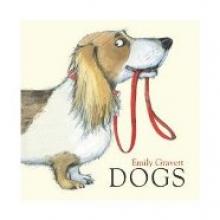
Dogs
Whether a “dog lover” or not, readers will delight in this clever, rhythmic story. Simple text and humorous illustrations are used to explore adjectives that describe dogs (“…hairy dogs and bald dogs. Stripy dogs and spotty dogs.”). Each double-spread shows a set of opposites and different breeds of canines. Ending with a surprise character, Dogs will leave children begging to read this tail-waggin’ book again and again.
Tips for Using with Children
Although the characters in this book are mostly dogs, their faces and body language are very expressive. After reading the story once, have children look at the Dog Personality Pictures from the book-integrated lesson plans on this website: Dog Personality Pictures. Have children come up with different words that describe each personality/dog. Next, reread Dogs and have children describe the personalities of the dogs in the illustrations. Children can use the Dog Personality Cards to compare and contrast the different types.
Tips for Using with Families
Explain to families where they can find the “end pages” of a book. End pages sometimes contain patterns, colors, or illustrations that give clues about the story to follow. Have families locate the end pages in the book which has labeled illustrations of dog breeds. Suggest that families look at the end pages with children before reading the story. After reading the story, have children go back and identify the different types of dogs by name.
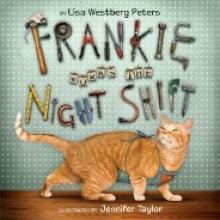
Frankie Works the Night Shift
When the lights go out at the hardware store, Frankie the cat is hard at work. “He empties one wastebasket, he cleans two counters, he calls three meetings” and when he finds an intruder in the store, he knows exactly what to do! Digital illustrations and concise, bold text makes this thrilling adventure a great choice for young children’s participation and offers a unique change to traditional counting books.
Tips for Using with Children
Read the story to children and have them look closely at the illustrations in this book. Children may notice that some look like real photographs. Have children create their own illustrations like the ones in this book. Using markers, crayons, paper, photographs, and magazine clippings, allow children to make a picture and come up with a story. If a child has a pet, let them incorporate a photograph of the animal into a funny illustration.
Tips for Using with Families
Explain to families that the digital photography in this book offers many opportunities for children to interact with the illustrations. Read the story to children and have them count specific items mentioned on each page (e.g., one wastebasket, two counters). Some of the illustrations resemble “I Spy” books and can be used for additional activities that incorporate counting. For example, on the first double-spread, ask, “Can you find three lamp posts?” or “How many windows do you see on this building? Can you find a building with more windows?”
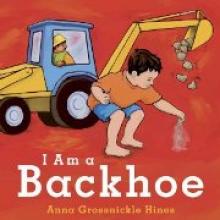
I Am a Backhoe
Little ones everywhere will enjoy this book, not only because they can read about construction vehicles, but because they can become one! Simple text and descriptive words guide children as they dig their "scooper hand" into the sand and dig, lift, turn, and tip like a backhoe. Bulldozers, dump trucks, rollers, and more come to life as children move like the machines. At the end of the book, the child’s father joins in the fun, and the couch becomes their "garage" as they read and transform into the vehicles together.
Tips for Using with Children
Children will love to act out the motions described in the story and transform into construction vehicles. Can they think of other vehicles they can become? What would they look like? Locate some props, such as a small bin of sand or a box of soft toys, and ask children to show you what each of the vehicles can do with the items. Help children to say the different sounds that vehicles make. If possible, visit a construction site where children can see construction in action!
Tips for Using with Families
In this book, the child’s father joins in the pretend play at the end of the book. Families can encourage children’s play and increase their enjoyment of the activity by joining in, too. Families may want to think ahead about what types of objects and props they can use from home to extend the play. Children may be familiar with some of the construction vehicles and may want to make up their own names or sounds for them. Families can include these names and sounds when they read to help build their child’s confidence and interest in reading. If children have some small toy trucks to play with, families can extend learning by taking some time to roll, tilt, dump, and beep with their child.
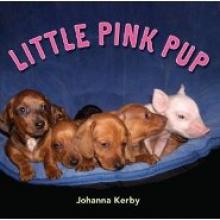
Little Pink Pup
Pink is the tiniest of a litter of 12 pigs born on a farm. When his siblings push him out of the way, he is brought into the farm house where a dachshund mom takes care of him as if he were her own pup. Children stay keenly interested in the bright photographs of Pink growing up and the heartwarming true story of love and acceptance.
Tips for Using with Children
Before reading, tell children that this is a true story and give them some of the information from the last page of the book. Children will enjoy talking about the love of the mother dog for all of her babies and Pink’s love of his dog family even when he moved out to the barn. They will like talking about the animals missing each other and their own experiences when they missed their family. Be sure to show them the last page with the picture of “mommy and baby” when Pink grew up.
Tips for Using with Families
Explain to families that this book is a great opportunity for a conversation about how some families are unique. They may look different, but the important thing is their love for each other. The love that families have for foster children or step children could also be discussed.
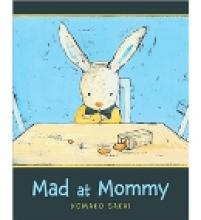
Mad at Mommy
Little Rabbit is out of sorts. He is mad at mommy for all kinds of reasons—real and imagined. His list of complaints begins with Mommy always and always sleeping late on Saturdays, and ends with Mommy not agreeing to marry him. He declares he is so mad he is leaving, but he’s quickly back and asks, “Mommy, did you miss me?” And she replies, “SO much!” Youngsters and adults will instantly understand Little Rabbit’s feelings in this emotion-filled, softly illustrated story.
Tips for Using with Children
Before reading, show children the cover of the book and tell them the book’s title. Ask children to predict why Little Rabbit might be mad at Mommy. Does Little Rabbit look mad? How you can tell? Read the story, pointing out the illustrations that enhance the text, especially Little Rabbit’s body language. After reading, point out that Little Rabbit seems frustrated or angry and ask children to explain how Little Rabbit was able to express or show his mad feelings. Tell children that we all feel mad or angry sometimes and that we can learn ways to express our anger without hurting others or ourselves.
Tips for Using with Families
Talk with families about the feelings expressed by Little Rabbit in the book. A book like this can help children to validate their feelings and learn ways to manage anger. Discuss other positive ways to respond to children who are “out of sorts” or angry such as creating a safe, emotional climate, using words to label feelings, and encourage talking about feelings.
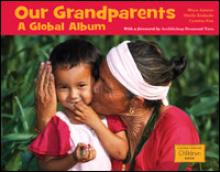
Our Grandparents: A Global Album
Grandparents love, listen, and play with us. They tell good stories and teach us what they know. The bond between children and their grandparents is explored in this beautifully photographed book with minimal text. Each double-page spread captures grandparents and their grandchildren engaged in a variety of cultural activities. Over thirty countries are represented in the images.
Tips for Using with Children
While reading this book with children, look at each double-page spread and invite children to explain how the pictures show what the text says. For instance, on the page with the text, “Grandparents explore the world with us,” the three photographs show the following: a child and grandparent in Japan looking and pointing at a computer screen; a child riding a sled while his grandparent is pushing him in Greenland; and a grandfather with his two grandchildren looking at an iguana through the display window at an animal park or zoo in the USA. Invite children to share ways that they explore the world with their grandparents. If your school or library celebrates Grandparent Day, this is a perfect book to use in your program.
Tips for Using with Families
At the back of this book is a section called “Five Things to Do with Your Grandparents.” The sections include: Play Together, Celebrate the Past, Record Memories, Plan an Adventure, and Learn About Your Family. Share each of these sections with families to encourage them to learn more about their parents and grandparents. Invite families to participate in these or similar activities with their children and extended relatives.
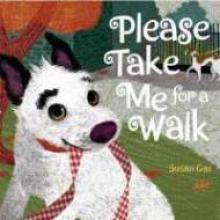
Please Take Me for a Walk
When readers of this story meet the adorable dog who is begging for a walk, they won’t be able to resist turning the pages and seeing where he goes next. The illustrations will draw readers in as they follow the dog’s trip through his neighborhood. There are different things to look at and find on each page, including a variety of other dogs and many special people and places. So curl up in a cozy place, and exercise your minds as you walk through the pages of this heartwarming story.
Tips for Using with Children
The perfect follow up to reading this story is to take a neighborhood walk with children. What types of animals, people, and places do you see? If a camera is available, it would be fun to take some pictures of your walk and create a poster or album of the things you saw when walking. In the story, it looks like dog is taking a walk during the fall season. What would happen if dog took a walk in the winter, spring or summer? What other things might he see or like to do?
Tips for Using with Families
Families can introduce some important ideas about caring for pets and dog safety when reading this book with children. Before reading the story, families can talk with children about what type of care a family dog needs. Why is it important to take them for a walk? What types of things can dog owners do to keep their pets safe when walking? Also, when walking with children, families may encounter an unfamiliar dog. Families can talk with children about safety tips when meeting a new dog. This book provides a great opportunity to introduce new words to children too, such as florist, greengrocer, and butcher.

Roly Poly Pangolin
There are many scary sights and sounds for a little animal in a big world, and Roly Poly does what pangolins do when they are frightened—he rolls up into a tight ball with his scales on the outside. When he peeks out, he sees another pangolin, and together they are able to face and enjoy the world. Children can easily relate to Roly Poly’s fears and relief at having companionship. They will enjoy the short, rhyming text and charming pictures.
Tips for Using with Children
Show children a picture of real pangolins and tell them where they live, what they eat, and some characteristics, including that babies travel on their mommies’ tails and that they roll up in a ball when they are frightened. Show them the cover picture and have the children try to roll up in a ball. After reading the story, encourage the children to explain some of Roly Poly’s fears and tell if they ever were afraid of the same things. Ask the children if they feel better about something of which they are afraid if they have someone with them. Children will have fun drawing a circle and making it into a picture of Roly Poly and his friends. They will notice the different colors of pangolins used in the book and may want to use a variety of colors.
Tips for Using with Families
This is a great book for suggesting that children draw and color their favorite part of the story. Explain to families that when young children draw pictures, they love to tell about them, giving them practice in developing language skills. Families can encourage this by asking questions about the picture. Another great language activity for families is to write down the child’s description of his/her drawing at the top or bottom of the paper and read it back to him/her. Sometimes children will want to try to write some of the sounds they hear in words or a few words they can spell.

Soup Day
Mmm! This book will satisfy you as a reader and as an eater. The little girl in the story excitedly announces to the reader that it is “soup day.” She and her mother work together to purchase and prepare the ingredients for a very special and delicious meal. Rich vocabulary is used to describe the vegetables and spices they use to make the soup, and the young girl continues to describe the shapes and sizes of the ingredients when they are cut up and added to the soup. Since waiting is a part of preparing most meals, mother and daughter play together as they wait for their soup to be ready. The book ends with a shared recipe for vegetable soup. This story is warm and inviting, and will make you hungry for another read—and maybe just plain hungry, too.
Tips for Using with Children
Include children in the preparation of snacks and meals. Children can benefit from many skills used in the preparation of food. Encourage children to help set the table, count out crackers, pour milk, or cut veggies for a homemade soup!
Tips for Using with Families
The family in this story is describing a tradition they have—making soup together on a cold, winter day. Talk to families about the traditions they have together. Is there something they do as a family that they would like to share with others? Do they have a special meal that they make on certain occasions? Families might like thinking about ways to include young children in these traditions, or they may want to try a new celebration—like soup day.
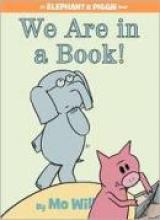
We Are in a Book!
In the newest adventure of Elephant and Piggie, these hilarious best friends find themselves literally stuck in the pages of a book! The story, told in word bubbles, follows the comical exchange between Gerald and Piggie as they explore the parts of a book and get the reader to say funny words like “BANANA.” However, what will happen when the book ends? The pair figures out a plan that will make this book a hard one to put down. Visit Mo Willems’ website for this list of books as well as games and other activities that children will enjoy.
Tips for Using with Children
This book is one of a series about Elephant and Piggie. Gather as many of the books as you can and talk about what a series is. Give children an opportunity to read/listen to the stories. This would be a good activity for reading partners. Invite children to share the books they enjoyed. Visit Mo Willems’ website.
Tips for Using with Families
Point out to families that this story is told through “speech bubbles” and simple text. After reading the story to children once or twice, let children help read the book. Show children that Gerald (the elephant) has gray speech bubbles and Piggie has pink ones to match their skin colors. Have the child choose a character to read, with the parent being the other character. Beginning readers can read the actual words, while younger children can come up with their own to recall what happens in the story. The colored bubbles will help children know when it is their character’s turn to speak.
